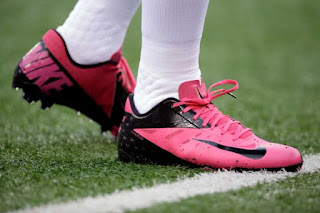A Pink October.
Lipstick, cleats, cookies, and guns - they have all been covered in pink!
Throughout the month of October you may have been exposed to the growing Breast Cancer Awareness movement washing pink over the country. You would be hard pressed to ignore this color soaked initiative - from shopping malls and grocery stores to your favorite websites and sporting events. A saturation of pink pop culture could be found in advertisements, food packaging, and everything in between, all in the name of a cure . It would seem every organization and company under the sun is a champion of the cause with intentions of raising funds for research of the disease that is estimated to kill 39,510 women this year with an estimated 226,870 being diagnosed.
In evaluation of these numbers, you can see breast cancer's impact is wide spread in the United States. Yet other illnesses are more deadly in women. For instance, heart disease kills the most women each year of any disease. Still it fails to garner the same far reaching scope of promotion and awareness. Breast cancer has spurred a giant industry of profits and donated millions in charitable funds each year, but why the mass marketing of this particular cause? The reasoning can likely be attributed to Susan G. Komen Foundation's monumental efforts to find a cure and the creation of National Breast Cancer Awareness Month by a pharmaceutical company now named AstraZeneca.
Where ever people can take sides, controversial debate will soon ensue. The topic of breast cancer awareness is no different. Cancer advocates have come out against all the warm and fuzzies of a Pink October, criticizing the methods used to raise awareness. Most notable of these groups are those diagnosed with breast cancer.
The ribbon is designed to prompt a cheery response, a dire contrast in feelings compared to those whose lives are fading to black because the cancer has ravaged their bodies. These people are seriously ill. It is a daily struggle for them. Curative treatments such as chemotherapy can break down the ravenous cancer, but may cause great pain and hardship. Patients can lose the simple freedoms of eating, drinking and many other routine activities often taken for granted. Some feel they do not have permission to experience their own feelings of grief and pain. They are encouraged to "fight" cancer, be a "solider" against the disease, stay strong, and become a "survivor". Being bombarded with positivity can be draining. It can make individuals suffering feel obligated to paste on a happy face, bottling their emotions in the midst of difficult circumstances. Grief is a natural reaction to such traumatizing situations of lose and hurt.
Some say the disease has been romanticized into a cutesy affair of "feminity" rallying for support with pleasant pink ribbons while avoiding the harsh realities of pain and death that come along with diagnosis. Also, critics contend measures to prevent the cancer are not discussed enough among awareness promoting companies. These same companies marketing pink products at times allegedly sell products that actually cause cancer or the companies pocket much of the profit rather than donating to charity. "Save the boobies!" we proclaim. It is all in good humor and an approach to getting the conversation on breast cancer awareness started, but the tactics and intent of "pinkwashing" are more frequently being called into question.
Dozens of rip-roaring articles, voices defending or antagonizing the cause, have washed over the internet. According to this Huffington Post article by AP journalist Kevin Begos, the Susan G. Komen Foundation began the first association of pink ribbons with breast cancer at a New York City race for cancer survivors. Flashy pink displays have increasingly flooded the market since that time and proved nothing less than a smashing success in expanding of the brand.
Since its founding in 1982, the Susan G. Komen Foundation has given $685 million to research and $1.3 billion to community programs geared toward helping people get mammograms for early detection of the disease. The spokesperson of Susan G. Komen has voiced an opinion unapologetic to criticism from detractors. The organization maintains the stance that research costs lots of money and money is what is required to solve this problem.
Creators of these campaigns have engineered clever ways of incorporating pink into their marketing efforts, furthering the reach of "pinkwashing". See the photos below for more examples of pink ads that spread awareness.
Though bizarre in some eyes, supporters have said that some advertisements has helped reach new audiences, potentially saving. This Forbes article by Amy Westervelt demonstrates each side to the breast cancer argument. It also relates a story of a family eating dinner around a pink KFC bucket promoting breast cancer awareness in which a mother's children saw the bucket and encouraged her to go to the doctor for a check-up. Stories such as this demonstrate some marketer's reasoning for pushing the pink agenda. Put plain and simple: it has an impact
What do you think? Has pink washing gone too far? Is the out pouring of support well meaning, but misplaced? Are critics who say we are over looking more dangerous diseases making a valid point? Or are the millions donated to fight this disease going to a good cause, where a quality marketing approach is only assisting in the search for a cure?
Let me know what you think! Check out more links below for further reading! And while you're at it, if you would like to have a real impact on patients with cancer and other terminal illnesses by visiting them as a hospice volunteer, please contact our office, Medi Home Health & Hospice at (804)732-0108 to find out more.
Barbara Ehrennreich - Welcome to Cancerland
Breast Cancer Advocates Reject "Pinkwashing"






No comments:
Post a Comment